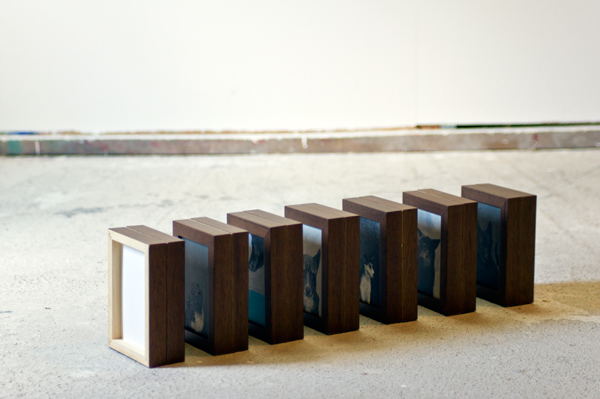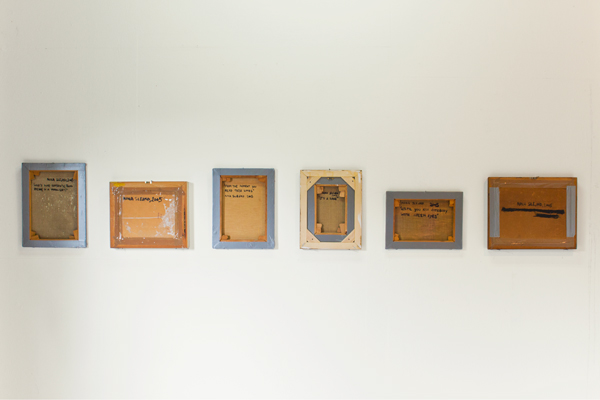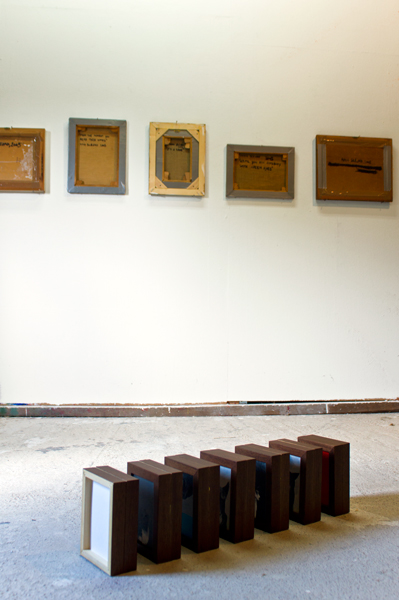
 |
|||||
| SLO below | Nina Slejko: It’s Already Been Shown (5 October - 6 October, 2011)
|
||
“It’s already Been Shown” consists of a short text and five sculptural installations made of paintings that have already been shown. In her work Nina Slejko (born 1982) continuously examines the art world, the mechanisms of the art market, and the minimalist heritage in art today. Through the years the white monochrome has kept intriguing her and she has done several works that approach this final monument of modernism with both humour and true devotion. In “It's Already Been Shown” she adapts the minimalist sculpture tradition in a similar manner. For the exhibition a small catalogue has been produced. Click HERE for Pdf (2.2Mb) version. More info at: http://www.ninaslejko.com/ |
|
||
Curator: CONNY BLOM |
|||
  |
|||
| Where is the curator who dares to show works based solemnly on the assessment of their quality, not hiding behind the theoretic constructions? As I see it, a curator’s work should be to see art, a lot of art, and based on these observations create own curatorial concepts, not, as I fear is happening increasingly, come up with innovative curatorial ideas and then start looking for works of art that will support this idea. Curatorial ideas should be based on developments in art, not the other way around. If one tries to squeeze a chicken into an egg there will surely be a mess. A curator is supposed to be an expert in art, someone who knows what is going on in the art world, and who has his or her tentacles out, constantly searching for the new. At the same time, however, it is virtually impossible for an artist to get to show their work to a curator unless they already belong to the same network. Curating is almost never impartial, and maybe it should not be. Of course one has much better chances to get a deeper insight in works of art one has frequent access to, than works one has briefly seen in a portfolio. What one could wish for is a transparency in the curatorial networks. There are expectations, especially on curators within institutions, to have an objective perspective, but this is of course impossible. It would be better if it was always clearly stated that what is provided in an exhibition is a subjective view. Instead of “this is what is relevant right now” would be “this is what curator x thinks is relevant right now”. These are of course only small changes in words, but it would maybe clarify a lot of the structures in the art world. It is not because artists are objectively exceptional that they succeed. Artistic success has more to do with networks and networking skills, than any objective truths. |
|||
Nina Slejko: Je že bilo razstavljeno "Je že bilo razstavljeno" je delo, sestavljeno iz kratkega besedila in petih skulpturalnih instalacij narejenih iz slik, ki so že bile razstavljene. Razstavo spremlja majhen katalog. Kliknite TU za pdf verzijo(2.2Mb) Več o umetnici in delu na: http://www.ninaslejko.com/ |
||
| Kurator: Conny Blom
Kuratorjem danes predstavlja največji izziv iskanje etičnega in odgovornega odnosa do umetnosti in umetnika. Število kuratorjev narašča in še toliko bolj, ko gre za “freelance”, samostojne kuratorje. To samo po sebi vodi do močnejše konkurence in večjih zahtev, vendar ali res tudi koristi umetnosti? |
 |
|
Kje je kurator, ki bi si upal predstaviti dela izbrana izključno na podlagi njihove kvalitete, brez da bi se skrival za teoretičnimi konstrukti? Kot to razumem sam, bi moral kurator opazovati umetnost, in temelječ na ugotovitvah sestaviti kuratorske koncepte. Ne pa, kot se dogaja vse pogosteje, si najprej zamisliti vse mogoče inovativne kuratorske ideje in nato iskati umetniška dela, ki jih bodo podprla. Kuratorske ideje bi morale bazirati na razvoju v umetnosti, in ne obratno. Če skušaš stlačiti jajce v kokoš, bo gotovo nastala godlja. Kurator naj bi bil ekspert umetnosti, nekdo, ki ve, kaj se dogaja v umetnostnem svetu in ki ima razprostrte tipalke na vse strani, stalno iskaje novosti. Istočasno je sicer praktično nemogoče, da bi lahko umetnik predstavil svoja dela kuratorju s komer ne sodita v isti krog poznanstev. Kuriranje ni skoraj nikoli nepristransko, in morda tudi ne bi smelo biti. Seveda je mnogo lažje dobro poznati in razumeti umetnikovo delo, če smo z njim v pogostih stikih in si ga lahko pogosto ogledamo, kot pa če ga le na hitro vidimo v portfoliu. Tisto, česar bi si bilo želeti, je transparentnost kuratorskih vezi. Obstajajo pričakovanja po objektivnih perspektivah, še posebej pri kuratorjih znotraj institucij, vendar tega ni mogoče resnično doseči. Bolje bi bilo, če bi bilo jasno navedeno, da je tisto, kar je postavljeno na ogled, subjektiven pogled kuratorja. Namesto ”to je tisto, kar je sedaj relevantno”, bi bilo treba izjaviti ”kurator x meni, da je to tisto, kar je sedaj relevantno”. Seveda so to majhne spremembe v besedah, vendar bi morda razjasnile mnogo struktur znotraj umetniškega sveta. Umetniki ne uspejo zato, ker so objektivno izjemni. Umetniški uspehi slonijo veliko bolj na vezah in poznanstvu ter spretnem mreženju, kot na kakršnihkoli objektivnih resnicah. |
||
| supported by |  |
|||
 |
||||